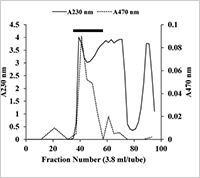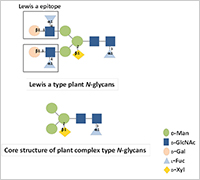Enlarge Image Enlarge Image
Links discovered between plant complex type N-glycans and hay fever
Okayama University researchers identify plants expressing substantial amounts of a nitrogen-linked polysaccharide – plant complex type N-glycans – which is linked to allergic responses in mammals, and may provide useful study models for understanding hay fever.
Researchers have noted the occurrence of plant complex type N-glycans on cedar pollen allergens, which carry a component called the “Lewis a epitope”. However previous studies found that rather than triggering allergic responses the core structure of plant complex type N-glycans may inhibit them. One of the main stumbling blocks in studies to understand the immunological significance of Lewis a type plant N-glycans studies has been the lack of means for preparing Lewis a type plant N-glycans in substantial amounts. The demonstration of high levels of plant complex type N-glycans expressed in three sea water plants provides a significant step forward for these studies.
The “epitope” is the part of toxic and foreign substances and other antigens that is recognised to trigger the immune system into action. In certain types of antigen – allergens – the epitope overstimulates the immune system.
In previous work the Okayama researchers reported that many types of seaweed and marine algae express high-mannose type N-glycans, but not plant complex type N-glycans. In this work they identify three water plants that instead have N-glycans bearing β1-2 xylosyl and/or α1-3 fucosyl residues but not high-mannose type.
Megumi Maeda, Yoshinobu Kimura and their colleagues at Okayama University studied the plants Elodea nuttallii, Egeria densa, and Ceratophyllum demersum. Structural investigations identified eight types of N-glycans. “Moreover, the Lewis a type plant N-glycans were commonly expressed in a substantial amount on the glycoproteins produced in these three water plants,” they add in their conclusions.
Land plants are well known to ubiquitously carry plant complex type N-glycans. Seaplants such as seaweed are thought to have evolved from land plants in the cretaceous period. Further genetic studies are underway to understand the why N-glycans expression differs in these plants and to identify any possible physicochemical or biological functions for these glycoproteins.
Publication and Affiliation
Megumi Maeda1,2,*, Misato Tani1, Takeo Yoshiie2, Christopher J. Vavricka1, Yoshinobu Kimura1,2, ** Structural features of N-glycans linked to glycoproteins expressed in three kinds of water plants: Predominant occurrence of the plant complex type N-glycans bearing Lewis a epitope. 2016 Carbohydrate Research 435 50-57
- Department of Biofunctional Chemistry, Graduate School of Environmental and Life Science, Okayama University, 1-1-1 Tsushima-Naka, Okayama 700-8530, Japan
- Department of Biofunctional Chemistry, Graduate School of Natural Science and Technology, Okayama University, 1-1-1 Tsushima-Naka, Okayama 700-8530, Japan
*corresponding authors, e-mail addresses: [email protected]*, [email protected]**.


